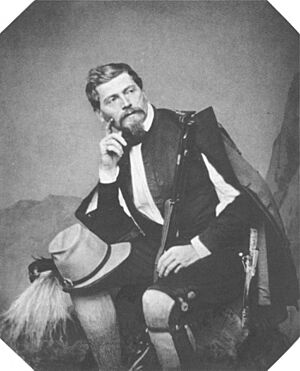Ludwig Freiherr von und zu der Tann-Rathsamhausen facts for kids
Quick facts for kids
Ludwig von und zu der Tann-Rathsamhausen
|
|
|---|---|

Photograph by Franz Hanfstaengl, c. 1860
|
|
| Born | 18 June 1815 Darmstadt |
| Died | 26 April 1881 (aged 65) Meran |
| Allegiance | |
| Service/ |
Bavarian Army Imperial German Army |
| Rank | General of the Infantry |
| Commands held | I Royal Bavarian Corps |
| Battles/wars | First Schleswig War Austro-Prussian War Franco-Prussian War |
| Awards | Military Order of Max Joseph Military Merit Order (Bavaria) Pour le Mérite Order of the Crown Order of the Red Eagle Iron Cross |
Ludwig Samson Heinrich Arthur Freiherr von und zu der Tann-Rathsamhausen (born June 18, 1815 – died April 26, 1881) was a famous general from Bavaria, a region in Germany. He was known for his leadership in several important wars during the 1800s, especially the Franco-Prussian War.
Contents
Early Life and Education
Ludwig was born in Darmstadt, Germany, on June 18, 1815. This was the same day as the famous Battle of Waterloo. His family, the von der Tanns, was very old and respected. In 1868, he added his mother's family name, Rathsamhausen, to his own.
When he was a baby, Ludwig I of Bavaria, who was the king of Bavaria, became his godfather. This showed that Ludwig was expected to have a great future. He received a very good education. In 1827, when he was just 12 years old, he became a page at the Bavarian royal court.
Military Career Beginnings
Ludwig started his military career in 1833, joining the artillery branch. Artillery uses large guns and cannons. After a few years, he joined the general staff, which helps plan military operations.
He even traveled to Italy to watch the Austrian army practice. He also joined a French military trip to Algiers for an adventure. This helped him learn more about different armies.
First Schleswig War (1848-1850)
When he returned, Ludwig became a close friend of the Bavarian Crown Prince Maximilian II of Bavaria. In 1848, he was promoted to major. That year, he showed great skill as a leader during the First Schleswig War. This war was fought between Denmark and a group of German states.
Ludwig led a special light corps and did very well. Because of his bravery, he received important awards. The King of Prussia gave him the Order of the Red Eagle. His own king gave him the Military Order of Max Joseph and promoted him to lieutenant-colonel. In 1849, he helped lead the Bavarian troops and fought bravely at Dybbøl.
Austro-Prussian War (1866)
After the First Schleswig War, Ludwig was called back to Bavaria. He continued to be promoted, becoming a colonel in 1851, a major-general in 1855, and a lieutenant-general in 1861. During these years, he was often with King Maximilian II of Bavaria.
In 1866, the Austro-Prussian War broke out. Ludwig served as the chief of staff for Prince Karl Theodor of Bavaria. Prince Karl led the troops from the southern German states. The war did not go well for the southern Germans. Many people blamed Ludwig, but the troops were not ready, and many soldiers were not interested in fighting.
Franco-Prussian War (1870-1871)
Despite the difficulties of 1866, Ludwig remained in favor with the king. In 1869, he was promoted to general of the infantry. He was also given command of the I Royal Bavarian Corps.
It was during the Franco-Prussian War of 1870-1871 that Ludwig truly became famous. He led his corps with great courage in important battles like Wörth and Sedan. Later in the war, he was given his own command near the Loire River. He had early successes and even captured the city of Orléans.
However, at the Battle of Coulmiers, he had to retreat because the French army was much larger. But after getting more troops, he fought several successful battles near Orléans again.
Later Life and Recognition
After the war ended, Ludwig was again made commander-in-chief of the I Royal Bavarian Corps. He held this position until he passed away in 1881 in Meran.
He received many high honors for his service. He was given the Grand Cross of the Bavarian Military Order. From the King of Prussia, he received the first class of the Iron Cross and the Pour le Mérite, which are very important military awards.
In 1878, the German emperor made Ludwig an honorary colonel of a Prussian infantry regiment. He also gave him a lifelong pension and named one of the new forts in Strassburg after him.
Honors and Commemoration
Ludwig von der Tann-Rathsamhausen was honored in many ways:
- A gunboat of the Schleswig-Holstein navy, Von der Tann, was named after him in 1849.
- The famous German World War I battlecruiser SMS Von der Tann was named in his honor.
- The 11th Royal Bavarian Infantry Regiment was named "Von der Tann" in 1900.
- Fort No. 8 at Strasbourg was named "Fort Tann" by Emperor Wilhelm I in 1873.
- He was made an Honorary Citizen of the City of Munich in 1871.
- A monument was built for him in Tann, Rhön, in 1900.
- Several streets in German cities, like Munich and Nuremberg, are named Von-der-Tann-Straße.
- A composer named Andreas Hager wrote a march called "General von der Thann march" in his honor in 1880.
Ludwig also received many military orders and decorations from different countries, showing his importance and bravery. Some of these included:
- The Military Order of Max Joseph (Bavaria)
- The Military Merit Order (Bavaria)
- The Pour le Mérite (Prussia)
- The Iron Cross (Prussia)
- The Order of the Red Eagle (Prussia)
- The Order of the Crown (Prussia)
- The Order of the Iron Crown (Austria)
- The Order of Leopold (Belgium)
- The Order of the White Eagle (Russia)

